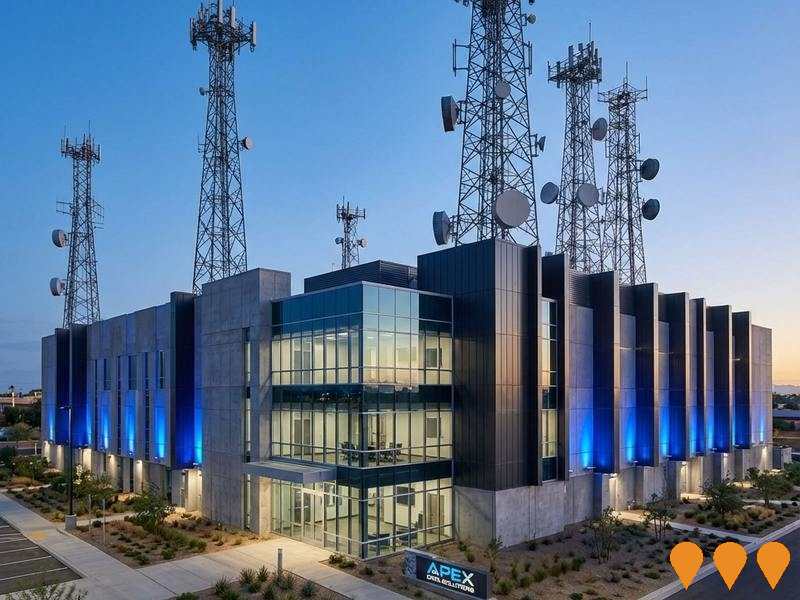Chart Color Schemes
est. as @ -- *
ABS ERP | -- people | --
2021 Census | -- people
Sales Activity
Curious about local property values? Filter the chart to assess the volume and appreciation (including resales) trends and regional comparisons, or scroll to the map below view this information at an individual property level.
Find a Recent Sale
Sales Detail
Population
An assessment of population growth drivers in St Arnaud reveals an overall ranking slightly below national averages considering recent, and medium term trends
St Arnaud's population is approximately 3,409 as of August 2025. This figure represents a decrease of 44 individuals since the 2021 Census, which reported a population of 3,453 people. The decline can be inferred from the estimated resident population of 3,407 in June 2024 and an additional 15 validated new addresses since the Census date. This results in a population density ratio of 1.1 persons per square kilometer. St Arnaud's population decline of -1.3% since the census is comparable to that of its SA3 area (-0.6%), indicating similar regional population trends. Overseas migration contributed approximately 89.5% of overall population gains during recent periods in the area.
AreaSearch uses ABS/Geoscience Australia projections for each SA2 area, released in 2024 with a base year of 2022. For areas not covered by this data, AreaSearch employs VIC State Government's Regional/LGA projections from 2023, adjusted using weighted aggregation methods to SA2 levels. Age group growth rates from these aggregations are applied across all areas for the years 2032 to 2041. By 2041, the area is projected to have an above median population growth of Australia's regional areas, expanding by 446 persons and recording a total gain of 13.0% over the 17-year period.
Frequently Asked Questions - Population
Development
The level of residential development activity in St Arnaud is very low in comparison to the average area assessed nationally by AreaSearch
St Arnaud has recorded approximately five residential properties granted approval each year over the past five financial years, totalling 27 homes. As of FY-26, three approvals have been recorded. On average, around 0.4 new residents per year arrive for each new home constructed between FY-21 and FY-25, indicating that new supply is meeting or exceeding demand. The average construction value of these properties is $302,000, which is below the regional average, suggesting more affordable housing options.
In FY-26, $7.0 million in commercial approvals have been registered, reflecting St Arnaud's primarily residential nature. Compared to the rest of Victoria, St Arnaud has significantly less development activity, with 54.0% fewer approvals per person. This limited new supply generally supports stronger demand and values for established homes. The area's development activity consists entirely of standalone homes, maintaining its traditional low density character with a focus on family homes. The estimated population per dwelling approval is 1140 people, reflecting the quiet, low activity development environment.
Population forecasts indicate St Arnaud will gain 443 residents by 2041. If current development rates continue, housing supply may not keep pace with population growth, potentially increasing competition among buyers and supporting stronger price growth.
Frequently Asked Questions - Development
Infrastructure
St Arnaud has moderate levels of nearby infrastructure activity, ranking in the 49thth percentile nationally
Changes to local infrastructure significantly impact an area's performance. AreaSearch has identified one major project likely affecting this region: Melbourne To Adelaide Freight Rail Improvements. Other key projects include Ararat to Maryborough Line Upgrades (Murray Basin Rail Project), Central Goldfields Land Use Planning Framework, and Western Highway Ballarat to Stawell Upgrade.
Professional plan users can use the search below to filter and access additional projects.
INFRASTRUCTURE SEARCH
 Denotes AI-based impression for illustrative purposes only, not to be taken as definitive under any circumstances. Please follow links and conduct other investigations from the project's source for actual imagery. Developers and project owners wishing us to use original imagery please Contact Us and we will do so.
Denotes AI-based impression for illustrative purposes only, not to be taken as definitive under any circumstances. Please follow links and conduct other investigations from the project's source for actual imagery. Developers and project owners wishing us to use original imagery please Contact Us and we will do so.
Frequently Asked Questions - Infrastructure
NSW Renewable Energy Zones (REZ) Program
NSW is delivering five Renewable Energy Zones (Central-West Orana, New England, South West, Hunter-Central Coast and Illawarra) to coordinate new wind and solar generation, storage and high-voltage transmission. The program is led by EnergyCo NSW under the Electricity Infrastructure Roadmap. Construction of the first REZ (Central-West Orana) transmission project commenced in June 2025, with staged energisation from 2028. Across the program, NSW targets at least 12 GW of new renewable generation and 2 GW of long-duration storage by 2030.
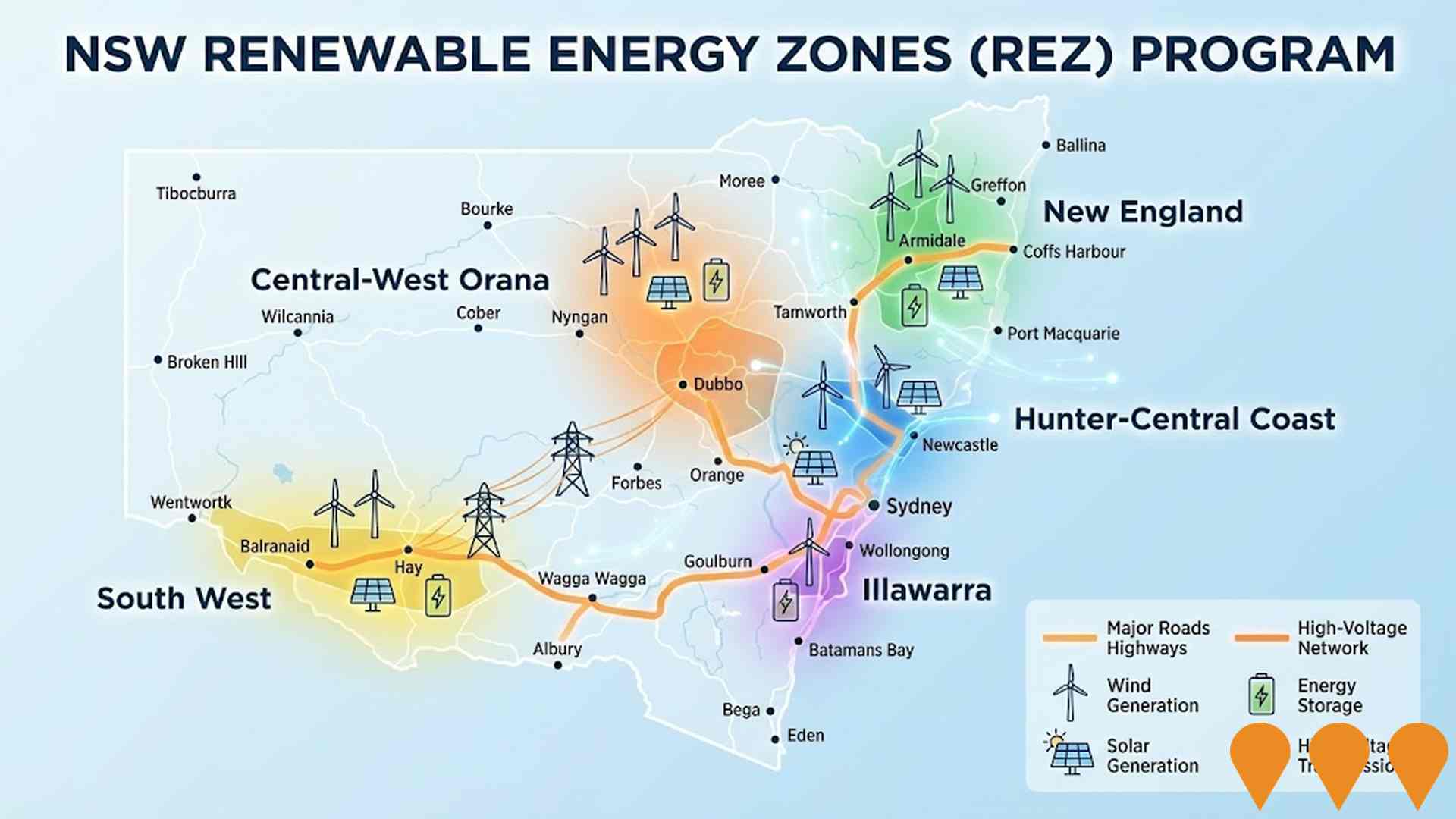
Victorian Renewable Energy Zones
VicGrid, a Victorian Government agency, is coordinating the planning and staged declaration of six proposed onshore Renewable Energy Zones (plus a Gippsland shoreline zone to support offshore wind). The 2025 Victorian Transmission Plan identifies the indicative REZ locations, access limits and the transmission works needed to connect new wind, solar and storage while minimising impacts on communities, Traditional Owners, agriculture and the environment. Each REZ will proceed through a statutory declaration and consultation process before competitive allocation of grid access to projects.
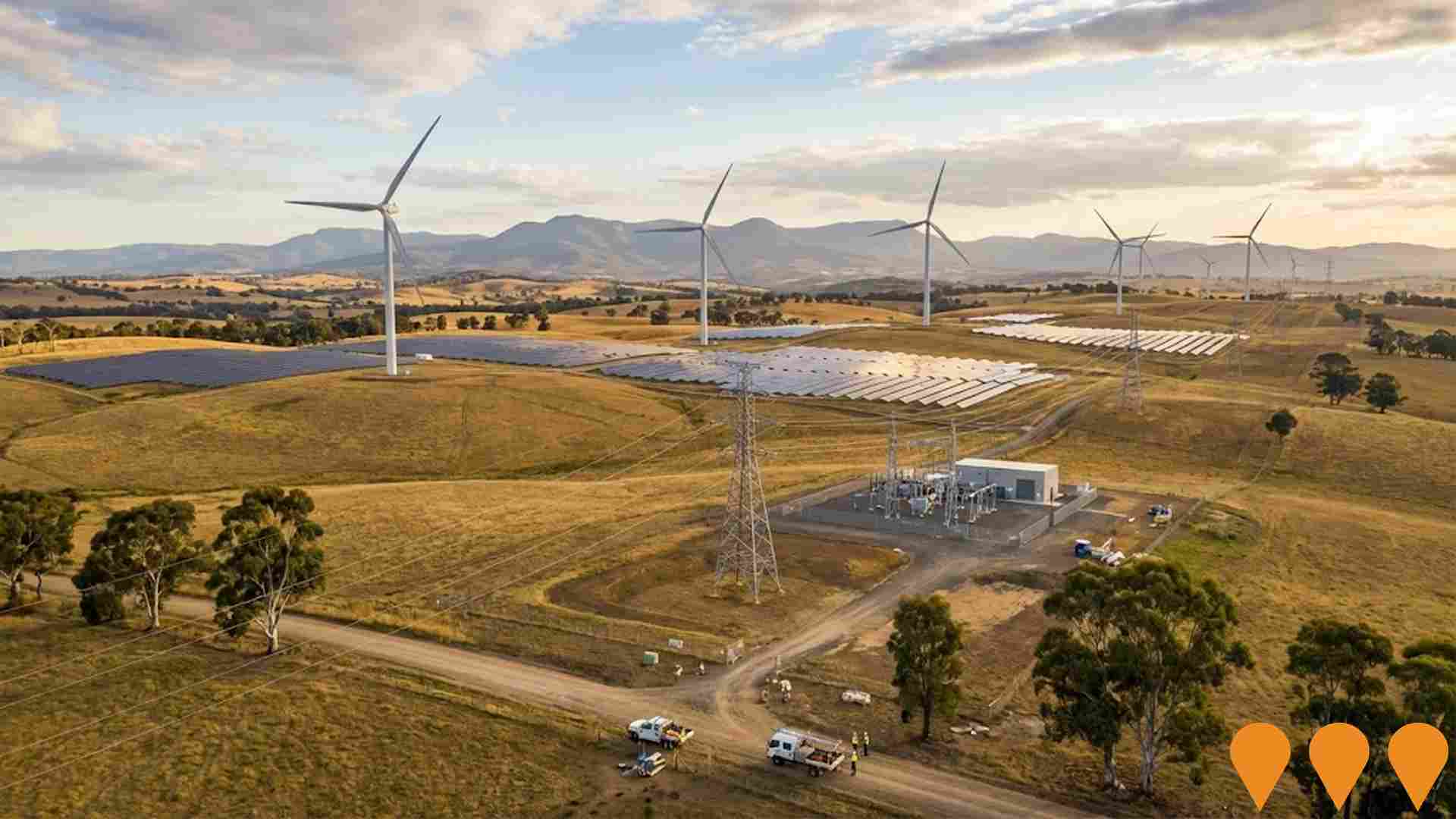
EnergyConnect
Australia's largest energy transmission project. A new ~900km interconnector linking the NSW, SA and VIC grids. NSW-West (Buronga to SA border and Red Cliffs spur) was energised in 2024-2025, connecting the three states via the expanded Buronga substation. NSW-East (Buronga-Dinawan-Wagga Wagga) is under active construction with substation upgrades at Wagga Wagga completed in June 2025 and works well advanced at Dinawan and Buronga. Full 800MW transfer capability is targeted after completion of the eastern section and inter-network testing, expected by late 2027.

Central Goldfields Land Use Planning Framework
Strategic planning project to identify areas for growth in Central Goldfields Shire to meet future housing and industrial needs. Community consultation has identified preferences for preserving rural lifestyle while supporting controlled development with appropriate infrastructure. Planning includes Maryborough, Carisbrook, and surrounding townships.

Western Highway Ballarat to Stawell Upgrade
Multi-billion dollar highway duplication project between Ballarat and Stawell, with 55km already completed between Ballarat and Buangor. The project includes adding two lanes in each direction with central median, upgrading intersections, and building new bridges. Benefits freight movement and regional connectivity including to Maryborough area.

Ararat to Maryborough Line Upgrades (Murray Basin Rail Project)
Reopening and subsequent upgrades of the 88 km Maryborough-Ararat freight line (Avoca line) as part of the Murray Basin Rail Project. Works delivered standard gauge, 21-tonne axle loading, new 47 kg rail and ballast, a new passing loop at Elmhurst (mid-2024), and associated junction/signalling upgrades. The line is operational; further signalling works around Maryborough continue under the broader program.
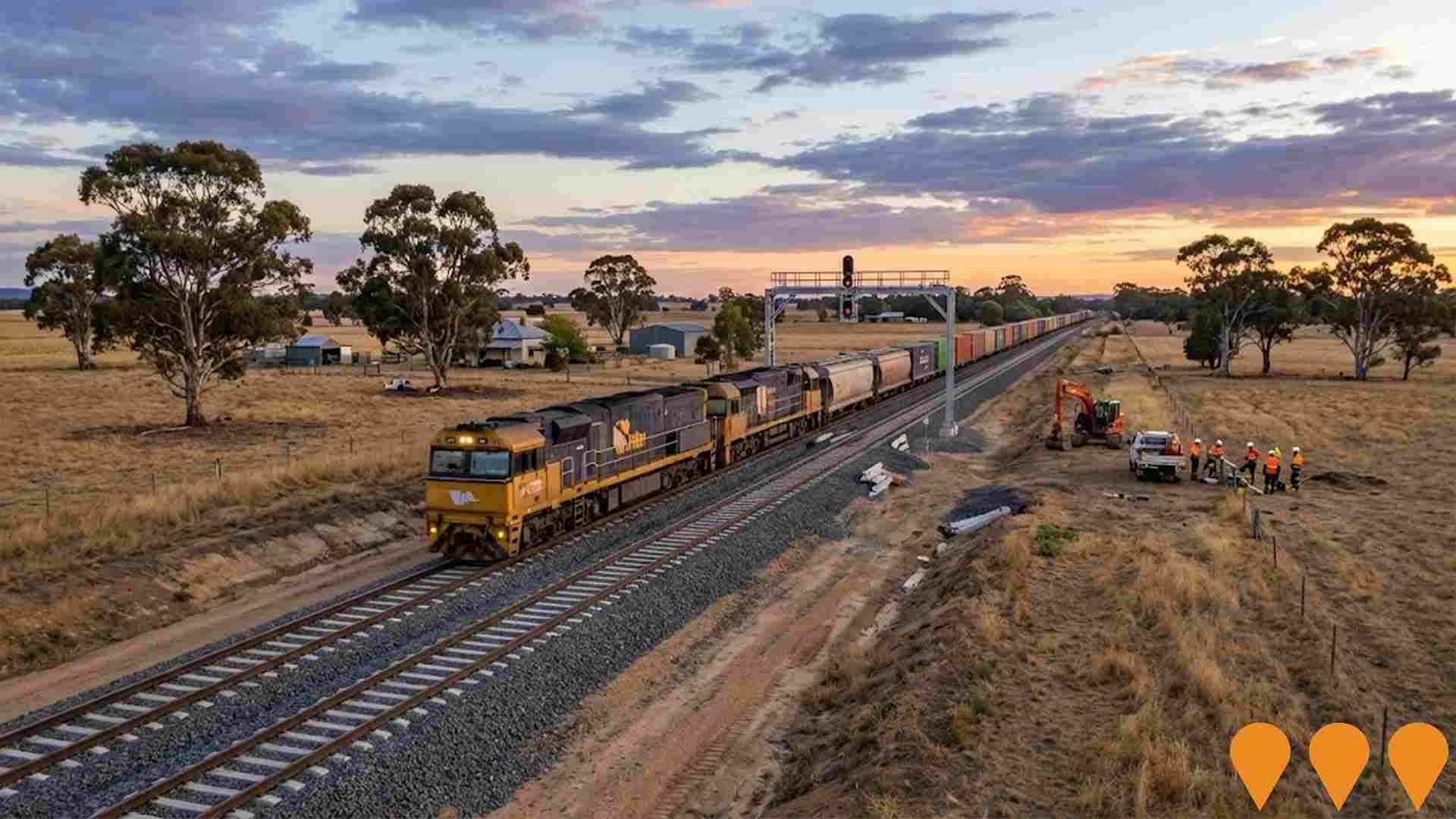
Regional Housing Fund (Victoria)
A $1 billion Homes Victoria program delivering around 1,300 new social and affordable homes across at least 30 regional and rural LGAs, using a mix of new builds, purchases in new developments, renewals and refurbishments. Delivery commenced in late 2023 with early completions recorded; overall fund completion is targeted for 2028.

NSW Heavy Vehicle Rest Stops Program (TfNSW)
Statewide Transport for NSW program to increase and upgrade heavy vehicle rest stopping across NSW. Works include minor upgrades under the $11.9m Heavy Vehicle Rest Stop Minor Works Program (e.g. new green reflector sites and amenity/signage improvements), early works on new and upgraded formal rest areas in regional NSW, and planning and site confirmation for a major new dedicated rest area in Western Sydney. The program aims to reduce fatigue, improve safety and productivity on key freight routes, and respond to industry feedback collected since 2022.
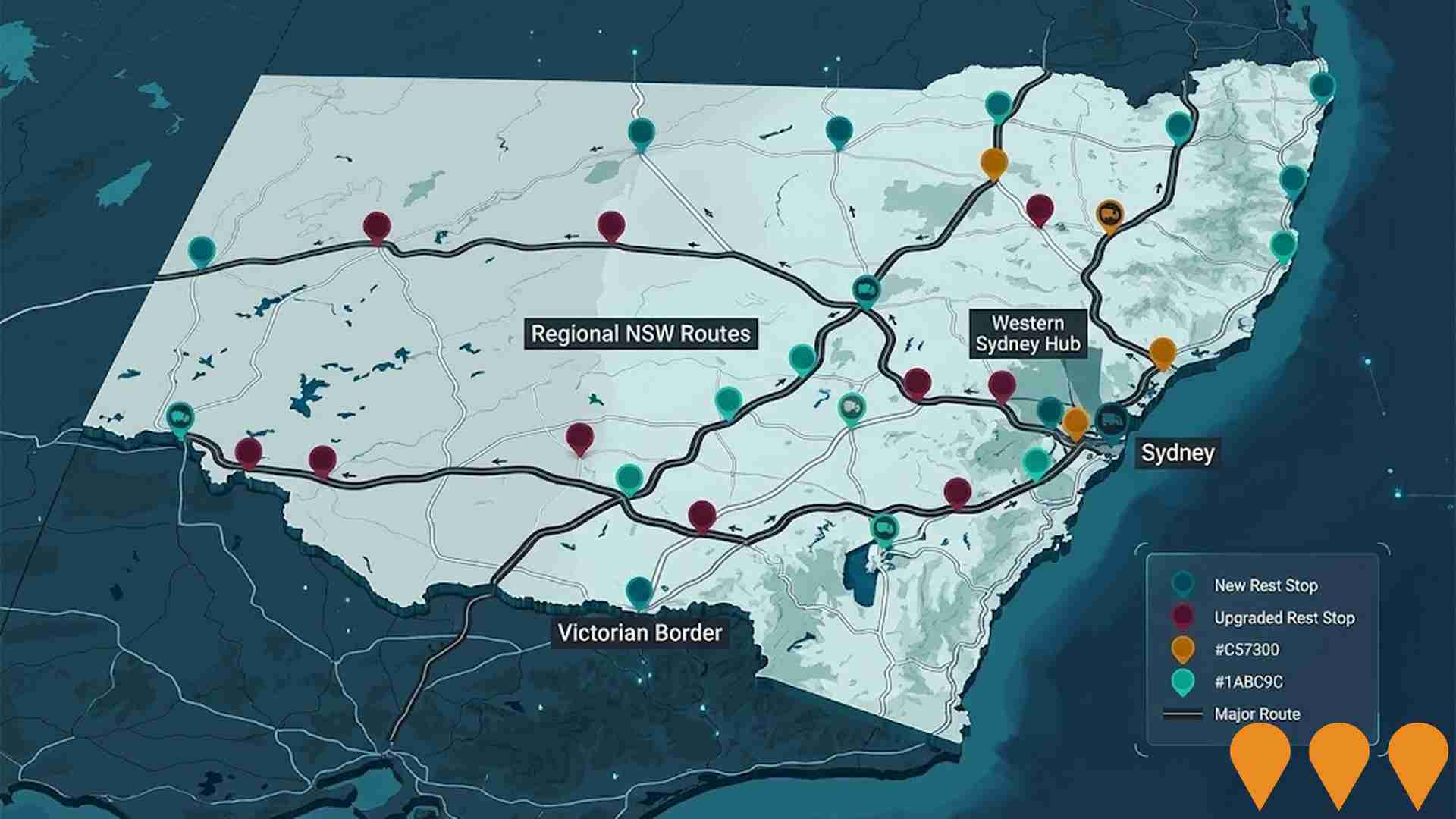
Employment
Despite maintaining a low unemployment rate of 3.3%, St Arnaud has experienced recent job losses, resulting in a below average employment performance ranking when compared nationally
St Arnaud has a balanced workforce with representation across white and blue collar jobs. The unemployment rate as of June 2025 is 3.3%.
There are 1,592 residents employed, which is 0.5% lower than the Rest of Vic.'s rate of 3.8%, but workforce participation lags at 51.6% compared to Rest of Vic.'s 57.4%. Key employment sectors include agriculture, forestry & fishing, health care & social assistance, and retail trade. The area specializes in agriculture, forestry & fishing, with an employment share 3.7 times the regional level, while construction employs only 4.7% of local workers compared to Rest of Vic.'s 10.4%. Between June 2024 and June 2025, labour force decreased by 4.2%, employment by 3.3%, leading to a 0.9 percentage point drop in unemployment rate.
In comparison, Rest of Vic. saw an employment decline of 0.9% and labour force decline of 0.4%, with unemployment rising by 0.4 percentage points. Jobs and Skills Australia's national employment forecasts from May 2025 project a 6.6% expansion over five years and 13.7% over ten years. Applying these projections to St Arnaud's employment mix suggests local growth of approximately 5.3% over five years and 12.0% over ten years, based on simple weighting extrapolation for illustrative purposes.
Frequently Asked Questions - Employment
Income
Income metrics place the area in the bottom 10% of locations nationally according to AreaSearch analysis
AreaSearch's latest postcode level ATO data for financial year 2022 shows that income in St Arnaud is below the national average. The median income is assessed at $43,101 while the average income stands at $51,473. This contrasts with Rest of Vic.'s figures where the median income is $48,741 and the average income is $60,693. Based on Wage Price Index growth of 12.16% since financial year 2022, current estimates would be approximately $48,342 (median) and $57,732 (average) as of September 2025. Census 2021 income data shows that household, family and personal incomes in St Arnaud all fall between the 3rd and 11th percentiles nationally. Looking at income distribution, the predominant cohort spans 31.7% of locals (1,080 people) with incomes in the $400 - $799 category, contrasting with the region where the $1,500 - $2,999 bracket leads at 30.3%. The prevalence of lower-income residents (40.6% under $800/week) indicates constrained household budgets across much of this suburb. While housing costs are modest with 91.6% of income retained, the total disposable income ranks at just the 8th percentile nationally.
Frequently Asked Questions - Income
Housing
St Arnaud is characterized by a predominantly suburban housing profile, with above-average rates of outright home ownership
In St Arnaud, as per the latest Census, 95.7% of dwellings were houses, with the remaining 4.3% comprising semi-detached homes, apartments, and other types. This is compared to Non-Metro Vic., where 93.0% were houses and 6.9% were other dwellings. Home ownership in St Arnaud stood at 57.0%, with mortgaged properties at 26.7% and rented dwellings at 16.3%. The median monthly mortgage repayment was $867, lower than Non-Metro Vic.'s average of $1,043, and the median weekly rent was $182, compared to Non-Metro Vic.'s $215. Nationally, St Arnaud's mortgage repayments were significantly lower at $867 versus Australia's average of $1,863, while rents were substantially below the national figure of $375.
Frequently Asked Questions - Housing
Household Composition
St Arnaud features high concentrations of lone person households, with a lower-than-average median household size
Family households constitute 59.8% of all households, including 20.7% couples with children, 29.3% couples without children, and 8.6% single parent families. Non-family households account for the remaining 40.2%, with lone person households at 38.0% and group households comprising 2.4%. The median household size is 2.1 people, which is smaller than the Rest of Vic. average of 2.2.
Frequently Asked Questions - Households
Local Schools & Education
Educational outcomes in St Arnaud fall within the lower quartile nationally, indicating opportunities for improvement in qualification attainment
The area's university qualification rate stands at 13.1%, significantly lower than Victoria's average of 33.4%. Bachelor degrees are the most common, with a rate of 9.8%, followed by graduate diplomas (2.2%) and postgraduate qualifications (1.1%). Vocational credentials are prevalent, with 39.8% of residents aged 15 and above holding them, including advanced diplomas (9.8%) and certificates (30.0%). In total, 24.5% of the population is engaged in formal education, comprising 9.7% in primary, 7.2% in secondary, and 2.0% in tertiary education.
St Arnaud's five schools have a combined enrollment of 385 students, operating under typical Australian school conditions (ICSEA: 980) with balanced educational opportunities. The area has four primary and one secondary school serving distinct age groups.
Frequently Asked Questions - Education
Schools Detail
Nearby Services & Amenities
Transport
Transport servicing is very low compared to other areas nationally based on assessment of service frequency, route connectivity and accessibility
The analysis of public transport in St Arnaud indicates that there are 12 active transport stops operating within the area. These stops serve a mix of bus routes, with a total of 10 individual routes providing service. Collectively, these routes offer 40 weekly passenger trips.
The accessibility of transport in St Arnaud is rated as limited, with residents typically located 682 meters from the nearest transport stop. On average, there are 5 trips per day across all routes, which equates to approximately 3 weekly trips per individual stop.
Frequently Asked Questions - Transport
Transport Stops Detail
Health
Health performance in St Arnaud is well below average with prevalence of common health conditions notable across both younger and older age cohorts
St Arnaud faces significant health challenges, with common conditions prevalent among both younger and older age groups. Private health cover is low at approximately 46% (1,581 people), compared to 48.8% across the rest of Victoria and a national average of 55.3%. The most common conditions are arthritis (11.9%) and mental health issues (9.4%), with 58.9% reporting no medical ailments, compared to 61.2% in the rest of Victoria.
St Arnaud has 28.7% (977 people) aged 65 and over, higher than the 25.2% in the rest of Victoria.
Frequently Asked Questions - Health
Cultural Diversity
The latest Census data sees St Arnaud placing among the least culturally diverse areas in the country when compared across a range of language and cultural background related metrics
St Arnaud, as per the census conducted on Tuesday 10 June 2008, displayed a low level of cultural diversity with 90.7% of its population being citizens, 93.4% born in Australia, and 97.4% speaking English only at home. Christianity was found to be the predominant religion in St Arnaud, with 57.4% of people identifying as such, compared to 51.6% across the Rest of Vic.. The top three ancestry groups in St Arnaud were English (35.2%), Australian (33.0%), and Irish (9.8%).
Notably, Scottish ancestry was overrepresented at 9.5%, compared to 9.0% regionally, Maltese at 0.4% versus 0.2%, and German at 3.0% versus the regional average of 6.6%.
Frequently Asked Questions - Diversity
Age
St Arnaud ranks among the oldest 10% of areas nationwide
St Arnaud's median age is 51 years, significantly higher than the Rest of Vic. average of 43 and considerably older than the Australian median of 38. Compared to the Rest of Vic., the 65-74 cohort is notably over-represented in St Arnaud at 15.8%, while the 25-34 age group is under-represented at 8.8%. This concentration of the 65-74 age group is well above the national average of 9.4%. Post-2021 Census data shows that the 35 to 44 age group grew from 8.4% to 10.3%, and the 15 to 24 cohort increased from 8.7% to 10.0%. Conversely, the 45 to 54 cohort declined from 12.8% to 11.2%, and the 55 to 64 group dropped from 16.6% to 15.5%. By 2041, St Arnaud is expected to see notable shifts in its age composition. The 45 to 54 age group is projected to grow by 38%, reaching 526 people from 380. Meanwhile, population declines are projected for the 55 to 64 and 65 to 74 cohorts.


